
These are page decorations from an instruction book(let) called 'American Clown: Athletic Dance for Men or Boys' by George Caskey (1886) - 2nd Ed. 1927 at the Rare Books and Special Collections site at the University of South Carolina.

'Doctor Panurgus', engraved by Martin Droeshout in the first half of the 17th century, after an engraving by Matthaus Greuter from 1600, after a 1596 emblem from the printshop of Theodore de Bry. That gives some indication as to the complicated nature of the print and it gives me some solace to learn that the professionals regard the substance and meaning of this work to be complex (welcome to my world). It's another of the Print of the Month entries at the British Printed Image to 1700 website, from where I've poached a couple of illustrations previously. I keep returning hoping to find more of the promised collection, but I'm probably in for an extended wait as the searchable database won't be completed until late next year.

'Noites jozephinas de Mirtilo, sobre a infausta morte do serenissimo senhor D. Jozé, principe do Brazil..., Lisboa, 1790' by Luís Rafael Soye {at the Portuguese National Digital Library}
[Elegiac poem on the death of D. José - containing an array of allegorical illustrations produced by 8 of the leading artists in Portugal in the late 18th century - source]

Frontispiece from a 1685 musical theory book by Manuel Nunes Silva called: 'Arte minima, que com semibreve prolaçam tratta em tempo breve, os modos da Maxima, & Longa Sciencia da Musica..' at the Portuguese National Digital Library.



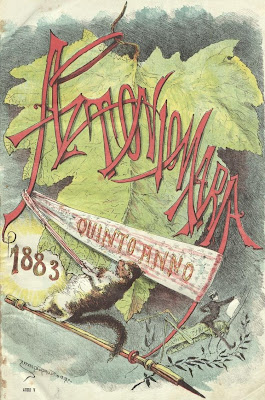

'O António Maria' was a popular satirical magazine in Portugal in the last twenty years of the 19th century. Lampoon targets were often drawn from contemporary social and political life in Lisbon, but there are some wickedly funny elements among the caricatures that have outlasted their local origins. Chief among contributing illustrators was Rafael Bordalo Pinheiro, Portugal's first major cartoonist.


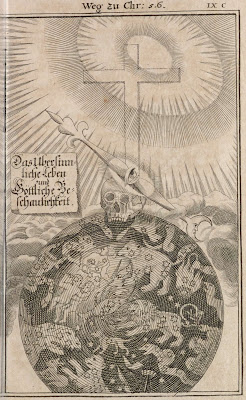



The above series of illustrations are from posthumously released books by Jakob Böhme, the German theosophical mystic [previously]. Wolfenbüttel Digital Library recently uploaded 'Weg zu Christo' (Way To Christ) [1634] and 'Seraphinisch Blumen-Gärtlein' [1700] --- although there are quite a few similarly impressive illustrations pertaining to Böhme online, these are the largest and best quality that I've come across. {Wolfenbüttel have a few more Böhme books, but I don't recall seeing further illustrations when I was scanning through them.}

The Tatler was a thrice weekly gentleman's periodical founded by Joseph Addison and Richard Steele and published between 1709 and 1711. Jonathan Swift may have been a contributor. Through a pseudonymous author, the journal reported local and foreign news, gossip, entertainment and literature. The news eventually gave way to a campaign for civility and politeness. The image comes from New Zealand's University of Otago exhibition website - A Quick Stab at the Eighteenth Century, a thematic presentation covering a wide variety of topics. [See also: The Tatler Volume 1 at Project Gutenberg; The Spectator Project at Rutgers University (contains all issues of The Tatler); Issuing Her Own: The Female Tatler, a student project from the University of Michigan)
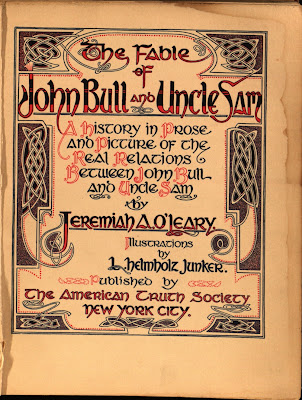
'The Fable of John Bull and Uncle Sam' 1900 by Jeremiah O'Leary with illustrations by L Helmholz Junker is online among the Joseph McGarrity books at Villanova University Digital Library. It is, by any measure, a very very strange book and also, very orange, but certainly interesting from a typographic standpoint. It's something of a compilation of newspaper articles/arguments and associated editorial cartoons.

'Le Maneige Royal' 1623 by Antoine De Pluvinel with illustrations by Crispin de Passe - a groundbreaking treatise on horsemanship. Image found on a bibliographic page at Vu de Loin. (more about the book)

"Map of the world in two thirty-six gore hemispheres. This image is the left sheet of a two-sheet map and is a north polar projection including North America, Caribbean islands, and northern part of South America. Cartographic elements include lines of latitude and longitude and some topographical details. Decorative elements include a medaillon portrait of Claudius Ptolemy. [..] The map is directly copied from Mercator's double-cordiform map of 1538." Found among the Archive of Early American Images (Insight browser) database at Brown University.
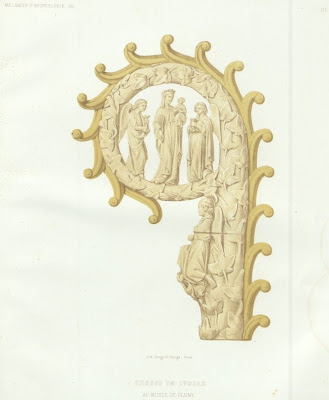
'Le Baton Pastoral. Étude Archéologique' 1856 by Abbot Barrault and Arthur Martin - a study of the decorative heads of pastoral staffs as they have developed over the centuries, from ancient times. The book contains 150+ illustrations including five chromolithographs and is online [although I couldn't get through at the time of writing today] at the Portuguese National Library [BND].

Titlepage from 'England Wales Scotland and Ireland described and abridged with ye historic relation of things worthy memory from a farr larger voulume' 1627 by renowned mapmaker/historian, John Speed. The image comes from somewhere in the Insightbrowser collection of Charting the Nation at the University of Edingburgh. [see: biography at mapforum and the John Speed map database at Occidental College, Los Angeles]

Folio 18r from MS Ashmole 399 at the Bodleian Library, Oxford University. Simply described as: "Anatomical illustration showing the veins, from a medical miscellany", produced in the late 13th century in England. Miscellaneous 13th-century manuscripts.

These are planetary orbital schematics from a 1485 version (by Erhard Ratdolt in Venice) of the famous 13th century 'De Sphaera', by Johannes de Sacro Bosco. 'De Sphaera' was a simplistic and accessible treatise that incorporated astronomical mathematics derived from Ptolemy and Arabic sources and outlined the spherical nature of the earth. That there were more than 100 editions released over 2 centuries serves to highlight the common held fallacy that medieval scholars believed the earth was flat. The image pastiche above was drawn from a digitised version of 'De Sphaera', among the Incunabula Collection at Mexico's University of Guadalajara.

'Birds in Harness' by Ruth Marten (2007). I suppose it's 'copyright Ruth Marten', who augments old engravings (in this case I think it's Georges Buffon's 18th century 'Histoire Naturelle'). Image from the Adam Baumgold Gallery. Artist website. She likes hair.
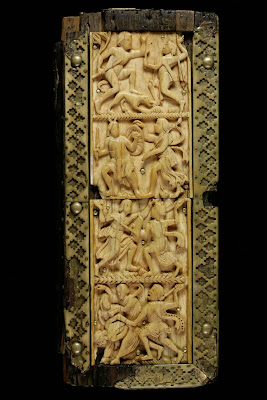
"The so-called Cantatorium of St. Gallen, the earliest complete extant musical manuscript in the world with neumatic notation. It contains the solo chants of the Mass and constitutes one of the main sources for the reconstruction of Gregorian chant. Written and provided with fine neumes in the monastery of St. Gallen between 922 and 926. Bound in a wooden box with an ivory panel on the front cover, most likely Byzantine c. 500, depicting scenes from the fight of Dionysos against the Indians. The ivory panel was once the possession of Charlemagne." See Codex 359 among the 144 medieval manuscripts online in the Digital Abbey Library of St. Gallen (CESG) in Switzerland.

'Cowskulls' by C Adams, 2005. (IN: Oregon) From the newest digital collection at the University of Wisconsin - Sixty Books Sixty Libraries. "This digital collection was a collaborative book arts, writing and journaling project for the people of south central Wisconsin. [..] The BFG book artists created sixty handmade blank books. Each book was catalogued into each of the sixty libraries in the South Central Library System. Unlike other library books, patrons were invited to write, draw, paint or collage in the books, producing community-wide collaborative works of art." I think it verges more towards ephemera than bookart strictly speaking, but there are some interesting contributions among the albums.

I think this is the most beautiful sketch of a tulip I've ever seen. In an album of 190 watercolour illustrations, Johann Bartholomäus Braun's 'Flora Picta' from ~1660 documented the garden of the Count of Baden-Durlach.

Hieronymous Braunschweig's 1497 treatise, 'Chirurgia'. [previously]
The above two images (both spliced together from screencaps) come from an outstanding (German) exhibition site devoted to hand-drawn illustrations, manuscripts and bookbindings from ten centuries: 'Göttinger Kostbarkeiten - Handschriften, Drucke und Einbände aus zehn Jahrhunderten'. The links down the page go to introductions to each section and the links across the top go to all the illustrations - there are some rare and unusual items here - and you need to click through each image to the flashzoom screens to see the full illustration.
Other things:
- The History of Visual Communication has an extensive array of images and commentary by Elif Ayiter, a graphic artist/academic from Sabanci University in Istanbul (among other places). Lots more to enjoy from the index page too. [And speaking of Istanbul, IDW - İstanbul Design Week, from 4 September, 2007 [via]]
- The National Gallery of Art in Washington DC have a current exhibition (and modest online selection) entitled Private Treasures: Four Centuries of European Master Drawings.
- Book artist, Denis Yuen --- weblog, studio, profile. Beautiful.
- Bookbindings as pictures, from The Arts Décoratifs Collection at Grabink (horizontal scroll) [via]
- The Rijksmuseum in Amsterdam have a great triple-presentation/slideshow about two recent acquisitions. The first is a tapestry cartoon (anon. from the 1500s) which was in poor condition when the museum received it - there are two segments, one outlining the nature and use of tapestry cartoons, and the other describing the restoration work they carried out. The third presentation shows how a Renaissance sketch artist (Barthelomeus Spranger) communicated modifications to his engraver, Jan Muller, in an ongoing exchange from different cities, until a final print was approved. This level of knowledge about the development of an engraving must be reasonably unique I would have thought.
- If you add the 40,000 artworks newly available from the German Zeno site [via] to the 70,000 works available from the Los Angeles County Museum of Art, you get a metric tonnage of digital artistic access.
- The current edition of the online journal, Common Place (from the American Antiquarian Society and Florida State University History Department), is entitled: 'Revolution in Print - Graphics in Ninteenth-Century America'. I haven't read any of the essays...yet!
- Old Book Illustrations is an intriguing site from France (in english) that is posting scans of engravings from (mostly) the 5-volume 'Dictionnaire Encyclopédique Universel Illustré' by Jules Trousset (around 1890). It's all arranged in categories with keyword search. There is also a weblog, in which our host, Lucilius, is periodically providing translations of the text that accompanied the images. If all that is not enough, there is a freely available zip file of a selection of high-res examples, which will be updated from time to time (but the regular pictures on the site are of a reasonable size anyway). Think: 19th century clipart.
- And for more modern clipart: Dryden Aircraft Graphics Collection - 'This collection contains digitized drawings, graphics and line art of many of the unique research aircraft flown at NASA Dryden Flight Research Center at Edwards, California from the 1940s to the present'.
- The new project at things magazine: The sketchbooks of Mrs Blaine, "a collection of drawings and watercolours by a C19 traveller in the Middle East."
- A link I've had for ages and forgotten to post: 'Painted Prints - The Revelation in Color' at the Baltimore Museum of Art - looking at the process, people and techniques behind the colouring of prints across 2 centuries.
- One last, lost, persistent link found under the rug in my computer's basement is the eclectic set of illustrations at the Virtual Library of Polish Literature in Gdańsk. That they are from Poland is about the only tenuous thread that seems to connect them all.

This gorgeous zodiac page (nearly forgotten) also comes from Brown University's Archive of Early American Images but unfortunately I didn't keep a record as to its name etc. Something about a portolan atlas...I think. [previously: The Portolan Atlas]


No comments:
Post a Comment